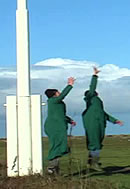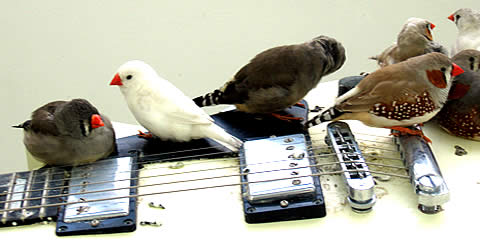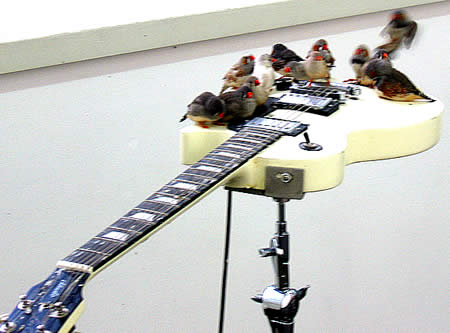june 2006 - s o _ w h a t' s _n e w ?
- s :
_several short soundblog related films @ Paris festivals
 * Rébus's uTube of Diktat
performing outdoors in Breda on an abandoned
public sound art work of the dutch artist Marinus Boezem is included
in the Noisebox section of the 2nd edition of Filmer
la Musique, a "film festival to be experienced as a rock festival",
at the Point Ephémère, Paris X (june 3-8) ;
* Rébus's uTube of Diktat
performing outdoors in Breda on an abandoned
public sound art work of the dutch artist Marinus Boezem is included
in the Noisebox section of the 2nd edition of Filmer
la Musique, a "film festival to be experienced as a rock festival",
at the Point Ephémère, Paris X (june 3-8) ;
* ookoi's pocket movies Jam
Karet I and Jam
Karet IV, shot during our residency
in the Archipel Media Lab in november 2007, have been selected as part
of the program of the fourth international Pocket
Film Festival, also in Paris, in the Centre Pompidou, june 13-16. Go
there and look for the Boîte à Malices ...
free lodgings, free food
may 14, 2008.
It was only after my visit to From here to ear - a sound environment by Céleste Boursier-Mougenot, on show (until saturday may 17th, 2008) in Galerie Xippas in the rue Vieille du Temple (Paris III) - that it occurred to me how, unwillingly, the french artist through this installation presents an image that will be but all too familiar to many contemporary improvising musicians: seemingly 'free as a bird', they actually have no choice but to let themselves, again and again, be 'locked' into some sort of a 'cage' in order to produce ephemeral sounds for a handful of passers-by, in exchange for nothing but free lodgings, free drinks and free food ... < ;-) ]

For From here to ear Céleste Boursier-Mougenot transformed part
of the gallery space into an aviary housing a couple of dozens of zebra
finches (fifteen males and fifteen females, to be precise). Along each
of two longish walls there is a broad stroke of grass (which did seem to
have a hard time growing there inside the gallery - maybe the finches have
been feeding on the seeds?), with a path in between, for visitors to follow.
[The path leads one into another part of the gallery space, in which
one may sit down on a Chesterfield leather couch to watch 'television',
as part of Zombiedrones, another work that is on show. In Zombiedrones
Céleste Boursier-Mougenot filters out the static parts of the emissions,
so that one ends up watching only the changing bits.]
On either of the strokes of grass there are one or two stands on which,
horizontally, an electric guitar has been fixed. These are perches for the
finches. Each of the guitars is connected to a fuzz-box which in turn is
connected to an amplifier. Also the fuzz boxes and amplifiers have been
placed on the strips of grass, in each of which there is a small guitar-shaped pond. One of these is filled with water,
for the birds to drink. The other contains what I guess must be bird food,
for the birds to eat. ( * )
The amplifiers are on ...

Rébus ![]() drew
our attention to the installation, by sending a link to a picture similar to the one above. And indeed
a major appeal of 'From here to ear' is that there's no need for words: a such picture
tells - or seems to tell - it all ...
drew
our attention to the installation, by sending a link to a picture similar to the one above. And indeed
a major appeal of 'From here to ear' is that there's no need for words: a such picture
tells - or seems to tell - it all ...
When visiting the gallery one has to climb a relatively steep staircase in order to get to the 'aviary', and while doing so, if you are lucky, even if you do not yet see, you may already hear the irregular metallic clanking and reverberating sounds of the distorted electric guitars that come whirling down. It makes one curious to find out what it is that is going on up there. To many the sounds will be familiar. And though a connoisseur might express doubts regarding the long term developments and overall structures within their daily performances, on the spur of the moment the zebra finches have what it takes to please the lovers of slow noise and free improvisation: they're predictably unpredictable in their picking of the strings, in their handling of the axe ...
Entering the 'bird cage' is sort of spectacular. At first sight it looks very sweet, very gentle. Very light. Very spring ... The children absolutely loved it ... (Part of the 'trick' being that I did not tell them beforehand what they were going to find; I let them discover it by themselves.)
Boursier-Mougenot has presented From here to ear before, also in different forms. Early 2000, for example, in the Contemporary Arts Center in Cincinnatti, Ohio (USA) the zebra finches played "taut harpsichord strings [and] wire coat hangers". The birds, caused by the visiting audience to move, perched on the different structures, and thus triggered "unique ambient sound patterns".
For of course one can think of a great many different ways in which zebra finches, other birds or even different sorts of animals, might, in a pseudo-aleatory manner, cause and/or interfere with certain objects and/or processes that might or might not be sound-producing ... Somewhere in my archives there are the yellowed sketches of ideas for a 'piece' called "Zes Geiten" (Six Goats), that Ronald Heiloo and I were toying with for a couple of weeks, sometime in the early 1980s. In one of the several possible variations on the theme we imagined how we would lead six real life goats together into a ring, like that for a boxing match, surrounded by seating for the spectators. Mingled with the members of the audience there would be the members of a choir, divided into six groups, each of which is linked to a specific goat, and reacting to the taped sounds and the actions of 'their' goat. We would tile the ring's floor with a great many switches, meant to control a number of tape machines. Some of these would play back sounds, others would record them. Sounds would be played back loudly, through speakers around and above the ring. The sounds recorded and played back on tape, as well as those of the choir members (intermittently - ensemble or individually - commenting through their singing and cheering, yelling, booing, whistling) were to surprise/alarm the goats, and hence cause them to move. Upon moving the goats would hit the switches, stop the playing back of some sounds, and start the sounding of others, from different directions, et cetera ...
We decided to try to work with goats because once let lose in a ring or on a stage, among domesticated animals, we thought that goats would bear the most resemblance to run-of-the-mill (pop) musicians ...
But of course zebra finches are só much more elegant; ánd they go só very well with the electric guitars ...
The guitar-birds' music will remind one of other musics in which electric guitars are being played without direct human intervention. First of all they of course make you think of the dropping of all sorts of objects from lesser or greater height on the strings of an electric guitar, which is one among several by now traditional 'non-traditional techniques' in instrumental free improvisation. Céleste Boursier-Mougenot's installation provides an interesting variation on (or should one look at it as a critique of ?) that principle. For me it also brought to mind Remko Scha's The Machines, where electric guitars are being played mechanically, by means of an ensemble of electric motors. The guitar-birds which, for all practical purposes, produce a music that is purely aleatoric, and the machine-guitars driven by (household) electro-mechanics, with a rhythmically regular, a law-like, result that is akin to guitar-based minimalist / overtone music like that of a Rhys Chatham or Glenn Branca) are antipoles.
...
However much I loved the elegant simplicity of the idea of birds + guitars, after a while its presentation at Xippas started to make me feel uneasy. The surprise of the first confrontation having faded, the soundscape of the - at times very listenable - random mingling of guitar sounds and bird song was somehow spoilt by the cold and clinical visual aesthetics. I looked around to find a place to sit down, and quietly listen for a while. I wanted to concentrate on the sounds. But there was no spot that invited one to do so. Therefore - as other visitors - I just walked up and down the middle lane for a while. Doing so, my attention started to be drawn by the somehow intimidating 'branding' of the equipment being used (something that, independently, also was commented upon by several other visitors of the show). From a mere detail, gradually this emphatic presence of 'commercial brand', of 'product', of 'luxury', of 'expensive' and its manifold socioeconomic connotations, began to take the center of the "show's stage" ... The near to bragging brand-display, with white Gibson Les Paul Studio guitars, Marshall amplifiers and Big Muff Electroharmonix distortion units, to me evoked a cold detachment that I associate with 'pop-as-business'. It counteracted and neutralized previous associations, of the frailness of the little flying creatures with 'sweetness', 'warmth' and 'sensuality', and so lead my attention away from the sounds that were being produced, onto more ambiguous realms ...
Did Boursier-Mougenot intend such reactions? I doubt that. Interesting though, come to think of it, this ambiguity with its contradictory 'messages'.
...
So then I wondered: what will happen to the guitars after the show? Of course a zebra finch doesn't care whether
it's a shitty unvarnished piece of wood or a shiny white Gibson that it is perching on ...
It sits on it, it shits on it.
Aren't these sort of 'sculptures' created by the finches? Will they be kept as they are now, bird shit and all?
Sold to collectors? Go back to some sponsors? Or will they, cleansed or not, be stocked by Céleste in his
studio or elsewhere,
until a next From here to ear?
And what will happen to the birds?
What will happen to the birds?
Who will look after them?
Who will look after da birds?
...
[ Rébus shot a short u-Tube at the gallery: One minute from here to ear ]
notes __ ::
(*) I found those 'guitar case ponds' somehow superfluous
and non-fitting, as they seemed to suggest that the work is about guitars;
which I don't think it is. [ ^ ]
tags: sound installation, electric guitar, birds
# .262.
comments for « free lodgings, free food » ::
|
Comments are disabled |